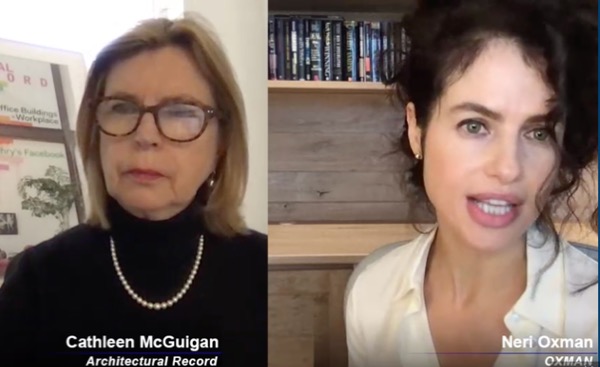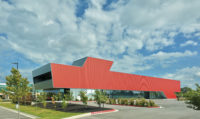Although attendance at Architectural Record’s 2020 Innovation Conference earlier this week was remote, one of the strongest themes throughout the two-day online event was how to bring people together. As a difficult year marked by disease and divisiveness—but also a remarkable push for social justice—comes to a close, the conference’s group of renowned speakers reflected on how the built environment—when designed with empathy—can be a healing force.

The first speaker, architect Jeanne Gang of Chicago-based Studio Gang—perhaps most widely known for her skyscrapers—focused instead on the firm’s outlook on “micro-urbanism,” a philosophy that grew from a 2008 community center project in the Auburn-Gresham neighborhood. Recalling the ways in which that building served as a catalyst for the area’s transformation, Gang discussed the need for good architecture—whether it be a step street or a boat house—to strengthen underserved areas. Through observing and talking to local citizens about the deficits and assets of their urban environments, Studio Gang’s proactive block-to-block approach to engaging communities in the design process—which has led to a number of actionable projects—celebrates the idiosyncrasies and nuance within a neighborhood. “Architecture is a big part of urbanism. It’s a spark that can really get change happening,” said the architect.

A panel on equity, access, and inclusion in public space, with Justin Garrett Moore, director of the New York City Public Design Commission, and Mitchell Silver, the commissioner of the New York City Department of Parks, continued the conversation on how architects and designers can be active agents of social change in urban communities. The discussion, as Moore put it, asked the audience to “question the architecture that creates a landscape of injustice,” whether it be poorly maintained parks or the use of potentially discriminatory language on placards, such as the words “no loitering.” The conference’s other two panel sessions, which included educators from Yale, Tuskegee University, the University of Texas at Arlington, NJIT, and IE University in Spain, touched on the various ways that architecture schools can more seriously address equity, not only in terms of creating more access for students, but also through the expansion and reframing of core curricula.

New York-based architect Thomas Phifer—designer of art institutions such as Glenstone, in Potomac, Marlyand, and the Corning Museum of Glass—and Fabrizio Barozzi, of the Barcelona firm Barozzi Veiga (a 2014 RECORD Vanguard), each presented cultural works in Europe with a strong public realm component. One of Phifer’s ongoing projects, a theater and museum near Warsaw’s Ministry of Culture draws on the capital’s rich cultural history to create a “direct, open, and optimistic architecture with a strong monumental presence,” said the architect, whose design, based on a series of arcades, allows citizens to “feel the pulse of the city.” Barozzi highlighted the importance of “absorbing the character and atmosphere of a place” while discussing his firm’s Musée Cantonal des Beaux-Arts in central Lausanne, a longitudinal concrete monolith that opened last year, and the Bündner Kunst in Chur, Switzerland, completed in 2016.

Similarly, the works of the Ghanian-born British architect David Adjaye—who delivered one of the conference’s keynote addresses—seek dialogue with their surrounding cultural contexts. In conversation with RECORD editor-in-chief Cathleen McGuigan, Adjaye talked of his spiritual projects in Africa, including the planned National Cathedral of Ghana—which features a dramatic concrete roof that appears as “billowing fabric,” said the architect—and the Abrahamic Family House, an interfaith complex in Abu Dhabi comprising a mosque, church, and synagogue, and slated for completion in 2022. “By renouncing differences and finding common ground in the roots of religion, the project uses architecture to bring about unity,” said Adjaye. He also showed the conceptual design for the Martyr’s Memorial in Niamey, Niger—a rhythmic labyrinth of 65-foot-high concrete pillars accompanied by a multi-use gathering space and a new urban plaza. “I wanted to create something greater than a place for reflection,” said the architect, “Something that has more of an everyday life.”

Another theme of this week’s conference was the role of computational design in the future of the profession. Architectural historian Mario Carpo, of the Bartlett School of Architecture in London, lectured on the limitations of digital fabrication methods such as 3D printing and CNC machines, namely the lack of reliable robotic tools for assembling large-scale structures. Multi-disciplinary designer Neri Oxman, founder of the Mediated Matter Group at the Massachusetts Institute of Technology, gave insight into how such tools might come to into play: one of her projects, for instance, is a series of giant, optical lens prototypes—3D printed with glass—that harvest solar energy. Oxman, whose work explores the nexus of design and biology, commented on the need for architects to invite scientific inquiry with innovation, and to view buildings not as solitary objects, but as complex ecological systems. “Only then will the art of building enable new forms of interaction between humans and their environment,” she said. “Only then will we be able to design and construct as equals.”

To cap off the two-day event, nonagenarian architect Frank Gehry brought the audience down to earth with some straight-forward wisdom. Reflecting on his decades-long career in Los Angeles, Gehry stressed the importance of digital design tools, being on time and on budget, and his dislike of the label “starchitect.” He appeared not as the designer of some of the world’s most dynamic and beloved buildings, but as a humanitarian dedicated to arts education for disadvantaged children and “bringing the fishies back” to the LA River. When asked what advice he would give young architects, Gehry remarked: “If they love it and need to do it, then they should do it.”





